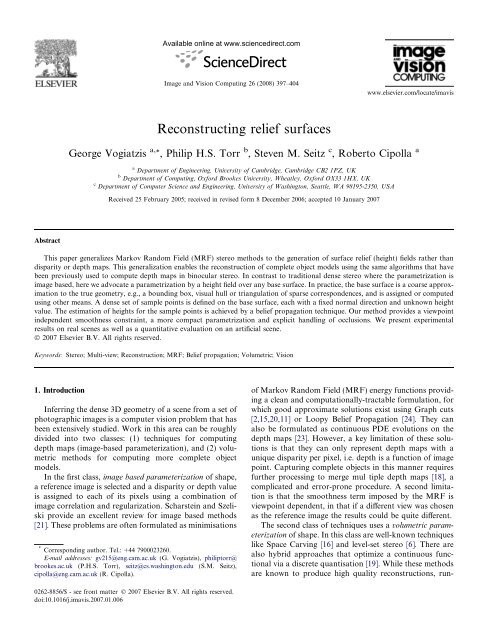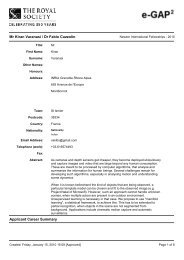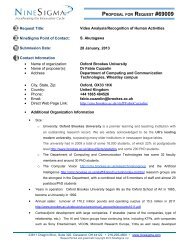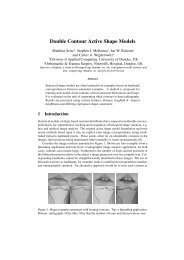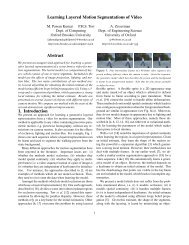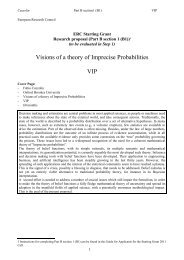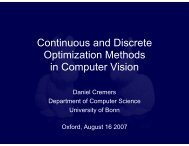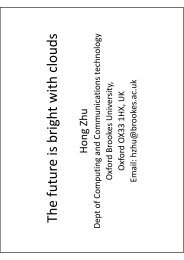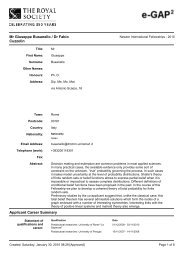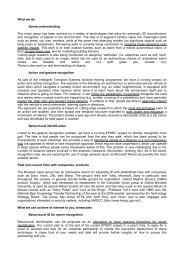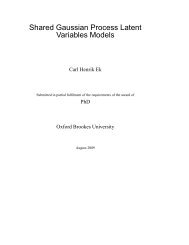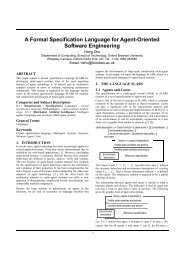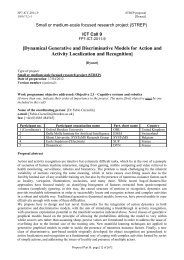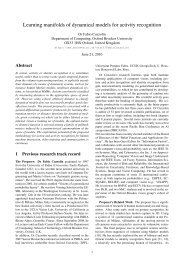Reconstructing relief surfaces - Oxford Brookes University
Reconstructing relief surfaces - Oxford Brookes University
Reconstructing relief surfaces - Oxford Brookes University
You also want an ePaper? Increase the reach of your titles
YUMPU automatically turns print PDFs into web optimized ePapers that Google loves.
Abstract<br />
<strong>Reconstructing</strong> <strong>relief</strong> <strong>surfaces</strong><br />
George Vogiatzis a, *, Philip H.S. Torr b , Steven M. Seitz c , Roberto Cipolla a<br />
a Department of Engineering, <strong>University</strong> of Cambridge, Cambridge CB2 1PZ, UK<br />
b Department of Computing, <strong>Oxford</strong> <strong>Brookes</strong> <strong>University</strong>, Wheatley, <strong>Oxford</strong> OX33 1HX, UK<br />
c Department of Computer Science and Engineering, <strong>University</strong> of Washington, Seattle, WA 98195-2350, USA<br />
Received 25 February 2005; received in revised form 8 December 2006; accepted 10 January 2007<br />
This paper generalizes Markov Random Field (MRF) stereo methods to the generation of surface <strong>relief</strong> (height) fields rather than<br />
disparity or depth maps. This generalization enables the reconstruction of complete object models using the same algorithms that have<br />
been previously used to compute depth maps in binocular stereo. In contrast to traditional dense stereo where the parametrization is<br />
image based, here we advocate a parametrization by a height field over any base surface. In practice, the base surface is a coarse approximation<br />
to the true geometry, e.g., a bounding box, visual hull or triangulation of sparse correspondences, and is assigned or computed<br />
using other means. A dense set of sample points is defined on the base surface, each with a fixed normal direction and unknown height<br />
value. The estimation of heights for the sample points is achieved by a belief propagation technique. Our method provides a viewpoint<br />
independent smoothness constraint, a more compact parametrization and explicit handling of occlusions. We present experimental<br />
results on real scenes as well as a quantitative evaluation on an artificial scene.<br />
Ó 2007 Elsevier B.V. All rights reserved.<br />
Keywords: Stereo; Multi-view; Reconstruction; MRF; Belief propagation; Volumetric; Vision<br />
1. Introduction<br />
Available online at www.sciencedirect.com<br />
Image and Vision Computing 26 (2008) 397–404<br />
Inferring the dense 3D geometry of a scene from a set of<br />
photographic images is a computer vision problem that has<br />
been extensively studied. Work in this area can be roughly<br />
divided into two classes: (1) techniques for computing<br />
depth maps (image-based parameterization), and (2) volumetric<br />
methods for computing more complete object<br />
models.<br />
In the first class, image based parameterization of shape,<br />
a reference image is selected and a disparity or depth value<br />
is assigned to each of its pixels using a combination of<br />
image correlation and regularization. Scharstein and Szeliski<br />
provide an excellent review for image based methods<br />
[21]. These problems are often formulated as minimisations<br />
* Corresponding author. Tel.: +44 7900023260.<br />
E-mail addresses: gv215@eng.cam.ac.uk (G. Vogiatzis), philiptorr@<br />
brookes.ac.uk (P.H.S. Torr), seitz@cs.washington.edu (S.M. Seitz),<br />
cipolla@eng.cam.ac.uk (R. Cipolla).<br />
0262-8856/$ - see front matter Ó 2007 Elsevier B.V. All rights reserved.<br />
doi:10.1016/j.imavis.2007.01.006<br />
www.elsevier.com/locate/imavis<br />
of Markov Random Field (MRF) energy functions providing<br />
a clean and computationally-tractable formulation, for<br />
which good approximate solutions exist using Graph cuts<br />
[2,15,20,11] or Loopy Belief Propagation [24]. They can<br />
also be formulated as continuous PDE evolutions on the<br />
depth maps [23]. However, a key limitation of these solutions<br />
is that they can only represent depth maps with a<br />
unique disparity per pixel, i.e. depth is a function of image<br />
point. Capturing complete objects in this manner requires<br />
further processing to merge mul tiple depth maps [18], a<br />
complicated and error-prone procedure. A second limitation<br />
is that the smoothness term imposed by the MRF is<br />
viewpoint dependent, in that if a different view was chosen<br />
as the reference image the results could be quite different.<br />
The second class of techniques uses a volumetric parameterization<br />
of shape. In this class are well-known techniques<br />
like Space Carving [16] and level-set stereo [6]. There are<br />
also hybrid approaches that optimize a continuous functional<br />
via a discrete quantisation [19]. While these methods<br />
are known to produce high quality reconstructions, run-
398 G. Vogiatzis et al. / Image and Vision Computing 26 (2008) 397–404<br />
ning on high resolution 3D grids is very computationally<br />
and memory intensive. Furthermore their convergence<br />
properties in the presence of noise are not well understood,<br />
in comparison with MRF techniques, for which strong<br />
convergence results are known. For Space Carving in particular,<br />
there is also no simple way to impose surface<br />
smoothness constraints.<br />
In principle MRF stereo methods could be extended to<br />
multiple views. The problem is that reasoning about<br />
occlusions within the MRF framework is not straightforward<br />
because of global interactions between points in<br />
space (see [15] for an insightful but costly solution for<br />
the case of multi-view depth-map reconstruction). In this<br />
paper, we propose extending MRF techniques to the<br />
multi-view stereo domain by recovering a general <strong>relief</strong><br />
surface, instead of a depth map. We assume that a coarse<br />
base surface is given as input. In practice this can be<br />
obtained by hand, by shape-from-silhouette techniques<br />
or triangulating sparse image correspondences. On this<br />
base surface sample points are uniformly and densely<br />
defined, and a belief propagation algorithm is used to<br />
obtain the optimal height above each sample point<br />
through which the <strong>relief</strong> surface passes. The benefits of<br />
our approach are as follows:<br />
(1) General <strong>surfaces</strong> and objects can be fully represented<br />
and computed as a single <strong>relief</strong> surface.<br />
(2) Optimisation is computationally tractable, using<br />
existing MRF solvers.<br />
(3) Occlusions are approximately modelled.<br />
(4) The representation and smoothness constraint is<br />
image and viewpoint independent.<br />
1.1. Related work<br />
Our work is inspired by displaced surface modelling<br />
methods in the computer graphics community, in particular<br />
the recent work of Lee et al. [17], who define a displacement<br />
map over subdivision <strong>surfaces</strong>, and describe a<br />
technique for computing such a representation from an<br />
input mesh. An advantage of this and similar techniques<br />
is that they enable the representation of finely detailed<br />
geometry using a simple base mesh.<br />
We also build on work in the vision community on<br />
plane-plus-parallax [3], model-based stereo [5], and sprites<br />
with depth [22]. All of these techniques provide means for<br />
representing planes in the scene with associated height<br />
fields. Our work can be interpreted as a generalization of<br />
plane-plus-parallax to a surface-plus-height formulation.<br />
Previous mesh-based multi-view stereo techniques operate<br />
by iteratively evolving an initial mesh until it best fits a<br />
set of images [14,26], or depth maps [10]. Representing<br />
finely detailed geometry is difficult for such methods due<br />
to the need to manage large and complex meshes. In contrast<br />
we assume a fixed base surface and solve only for a<br />
height field providing a much simpler way of representing<br />
surface detail. We also use a more stable estimation prob-<br />
lem with good convergence properties. Ultimately, a hybrid<br />
approach that combines surface evolution and height field<br />
estimation could offer the best of both worlds and is an<br />
interesting topic of future work.<br />
2. Model<br />
The theory of Markov random fields yields an efficient<br />
and powerful framework for specifying complex spatial<br />
interactions between a number of discrete random variables<br />
h1,...,hM, usually called sites. Each site can take<br />
one of a number of values or labels H1,...,HL. The first<br />
ingredient of the model is a labelling cost function Ck(hk)<br />
that measures how much a site is in agreement with being<br />
assigned a particular label. The second ingredient is the<br />
interaction between sites, which, in a pairwise MRF such<br />
as the one considered in this paper, is modelled through<br />
a symmetric neighbourhood relation N as well as a compatibility<br />
cost term Ckl(hk,hl) defined over neighbouring<br />
sites. This cost term measures how compatible the assignment<br />
of any two neighbouring labels is. The cost of cliques<br />
(fully connected subgraphs) with more than two nodes is<br />
set to zero. With these energy functions defined, the joint<br />
probability of the MRF is:<br />
Prðh1; ...; hMÞ ¼ 1<br />
Z exp<br />
XM<br />
k¼1<br />
CkðhkÞ<br />
X<br />
ðk;lÞ2N<br />
Cklðhk; hlÞ<br />
ð1Þ<br />
where Z is a constant.<br />
To bring multi-view stereo into this framework a set of 3D<br />
sample points X1,X2,...XM is defined on a base surface. The<br />
neighbourhood relation N defined between the sample<br />
points can be obtained in a number of ways, some of which<br />
are discussed in the next subsection. At each sample point<br />
Xk, the unit normal to the base surface at that point, nk is<br />
computed. The sites of the MRF correspond to height values<br />
h1,...,hM measured from the sample points X1, X2,...XM along the normals n1, n2,..., nM (see Fig. 1 left). The labels<br />
H1,...,HL are a set of possible height values that variables<br />
hk can take. If the kth site is assigned label hk then the <strong>relief</strong><br />
surface passes through 3D point Xk + hknk. To deal with<br />
the problem of occlusion, the base surface has to contain<br />
the <strong>relief</strong> surface for reasons that will be explained in Section<br />
2.2. Hence if the positive normal direction is defined to be<br />
towards the interior of the volume, only positive (inward)<br />
heights need be considered. The labelling cost is related to<br />
the photo-consistency [16] of the 3D point Xk + hknk while<br />
the compatibility cost forces neighboring sites to be labelled<br />
with ‘compatible’ heights. The following sections discuss<br />
how to define the sample point neighbourhood relation, as<br />
well as the two terms of the cost functional in more detail.<br />
2.1. Sample point neighbourhood<br />
The neighbourhood relation between sample points can<br />
in principle be obtained by a simple thresholding of the<br />
!
Euclidean distance between sample points. A slightly more<br />
principled way that is also useful for extracting a surface<br />
from the estimated height field, is to obtain a triangulation<br />
of the sample points and then use the edges present in the<br />
triangulation as neighbour links. This has the advantage<br />
that for a well behaved regular triangulation (i.e. one with<br />
mostly equilateral triangles) the number of neighbours is<br />
usually around 6, while there is no need for any distance<br />
threshold. Such triangulation can usually be obtained from<br />
a coarse mesh using standard mesh subdivision algorithms<br />
such as [13].<br />
After the optimal height has been obtained for every<br />
sample point, this triangulation can be lifted to the height<br />
field points Xk + hknk so that a mesh surface is automatically<br />
obtained from the height field.<br />
2.2. Labelling cost<br />
The data are n images of the scene I1,...,IN, with known<br />
intrinsic and extrinsic camera parameters. We will be<br />
denoting by Ik(X) the intensity of the pixel onto which<br />
the 3D point X is perspectively projected by the camera<br />
that captured image Ik. As mentioned, labelling a site with<br />
a height value corresponds to a point in space through<br />
which the <strong>relief</strong> surface passes. Let that point be Xk + hknk<br />
and let the intensities of the pixels to which it projects be<br />
i1(hk) =I1(Xk + hknk),...,iN(hk)=IN(Xk + hknk). If the<br />
point is part of the true scene surface these intensities<br />
should be consistent. Let .{i1,i2,...,in} be some measure<br />
of consistency of the intensities. In experiments presented<br />
here this was set to the standard deviation of the intensities<br />
(which corresponds to the Lambertian reflectance model)<br />
but other measures could be used instead [12,8]. Then<br />
CkðhkÞ ¼w1. fi1ðhkÞ; ...; iNðhkÞg<br />
ð2Þ<br />
is defined as a measure of the consistency of the assignment<br />
of height hk to sample point Xk for some weight parameter<br />
w1. This however does not take occlusion into account and<br />
will lead to erroneous reconstructions if not all points are<br />
visible from all images. If we also require the base surface<br />
to be outside the true scene surface, as would be the case if<br />
it was obtained through the visual hull [4] for example, then<br />
G. Vogiatzis et al. / Image and Vision Computing 26 (2008) 397–404 399<br />
H<br />
H<br />
H<br />
4<br />
3<br />
H1 2<br />
nk Xk Fig. 1. The 3D MRF model. Left: Sample points X k (black dots), are defined on a base surface and surface normals n k, are computed at those points. A<br />
neighbourhood relation N (dashed lines) is defined between the sample points. Labels H i (white dots) are heights above the sample points. In the figure a<br />
set of 3 labels for a sample point are depicted, each of which corresponds to a 3D location in space. The cost of assigning a height to a sample point is<br />
based on the photo-consistency of the corresponding 3D location. Right: The smoothness cost involves terms proportional to distance between<br />
neighbouring <strong>relief</strong> surface points. The figure shows a 1D MRF where the smoothness cost forces minimum length. In the 2D case, an approximation to<br />
surface area is minimized.<br />
it can be used as the occluding volume through which visibility<br />
can be inferred. In this case only positive heights<br />
(going into the volume) have to be examined. Such an<br />
occluding volume guarantees that no location in space outside<br />
or on the boundary of the volume is considered visible<br />
from an image if it is occluded by the true scene surface. On<br />
the other hand there may be visible locations that are erroneously<br />
considered occluded. For a proof of this claim see<br />
[16].<br />
Note that the volume of the base surface cannot provide<br />
accurate information for the visibility of locations<br />
inside it. It can be used however as an approximation<br />
by assuming that Xk + hknk has the same visibility as<br />
Xk for the small range of heights we are considering.<br />
The base surface is therefore used to define a visibility<br />
map Vn(Xk) that is 1 when Xk is visible from image n<br />
and 0 otherwise. Taking this into account the labelling<br />
cost is set to<br />
CkðhkÞ ¼w1. finðhkÞ : V nðXkÞ ¼1g:<br />
ð3Þ<br />
2.3. Compatibility cost<br />
As mentioned previously, the dense stereo problem is ill<br />
posed and some form of regularization is necessary. In a<br />
3D, non regular MRF, defining the notion of ‘compatible’<br />
neighbouring heights presents a challenge. In the simple<br />
case where base surface normals are parallel (planar<br />
regions) and distances between sample points are constant,<br />
simple choices for the compatibility cost such as ihk hli or ih k<br />
h li 2 work adequately. These costs also permit a sig-<br />
nificant speed up to the BP algorithm described in [7]. They<br />
are not very meaningful however for curved base <strong>surfaces</strong><br />
where the distance between sample points and direction<br />
of surface normals need to be taken into account. The cost<br />
function<br />
Cklðhk; hlÞ ¼w2dklðhk; hlÞ ð4Þ<br />
with some weight parameter w2 and dkl(hk,hl)=i(Xk +<br />
hknk) (Xl + hlnl)i, penalizes the Euclidean distance between<br />
neighbouring <strong>relief</strong> surface points. It favours minimal<br />
area <strong>surfaces</strong> and is meaningful for arbitrary
400 G. Vogiatzis et al. / Image and Vision Computing 26 (2008) 397–404<br />
configurations of base surface and sample points (Fig. 1<br />
right).<br />
3. Optimisation<br />
The MRF model laid out in the previous section provides<br />
a probability for any possible height labelling and<br />
corresponding <strong>relief</strong> surface. MRF inference involves<br />
recovering the most probable site labelling which is an<br />
NP-hard optimization problem in its generality [15]. Fortunately<br />
a number of efficient approximate algorithms have<br />
been proposed such as graph cuts [1] and belief propagation<br />
[24]. These methods have been shown to give very<br />
good results in a depth-map setting (see [21,25] for a comparison).<br />
In this work we choose to apply a belief propagation<br />
scheme which we outline in the following section.<br />
3.1. Loopy belief propagation<br />
Belief propagation works by the circulation of messages<br />
across neighbouring sites. Each site sends to each of its<br />
neighbours a message with its belief about the probabilities<br />
of a neighbour being assigned a particular height. The clique<br />
potentials<br />
UkðhkÞ ¼exp ð CkðhkÞÞ<br />
ð5Þ<br />
and<br />
Wklðhk; hlÞ ¼exp ð Cklðhk; hlÞÞ<br />
ð6Þ<br />
are precomputed and stored as L · 1 and L · N matrices,<br />
respectively. Now suppose that mij(hj) denotes the message<br />
sent from sample point i to sample point j (this is a vector<br />
indexed by possible heights at j). We chose to implement<br />
the max-product rule according to which, after all messages<br />
have been exchanged, the new message sent from k to l is<br />
emkl ¼ max UkðhkÞWklðhk; hlÞ<br />
hk<br />
Y<br />
mikðhkÞ: ð7Þ<br />
i2NðkÞ flg<br />
The update of messages can either be done synchronously<br />
after all messages have been transmitted, or asynchronously<br />
with each sample point sending messages using all<br />
the latest messages it has received. We experimented with<br />
both methods and found the latter to give speedier convergence,<br />
which was also reported in [25].<br />
3.2. Coarse to fine strategy<br />
One of the limitations of loopy belief propagation is that<br />
it has significant memory requirements, especially as the<br />
size of the set of possible heights is increased. In the near<br />
future bigger and cheaper computer memory will make this<br />
problem irrelevant, but for the system described in this<br />
paper we designed a simple coarse to fine strategy that<br />
allows for effective height resolutions of thousands of possible<br />
heights. This strategy effectively, instead of considering<br />
one BP problem with L different labels, considers<br />
logL/logl problems with l labels where l L. It therefore<br />
also offers a runtime speedup since it reduces the time<br />
required from O(ML 2 )toO(logL Ml 2 /logl).<br />
Initially the label set for all sites corresponds to a coarse<br />
quantization of the allowable height range. After convergence<br />
of the Belief Propagation algorithm each site is<br />
assigned a label. In the next iteration a finer quantization<br />
of the heights is used within a range centered at the optimal<br />
label of the previous iteration. The label set is now allowed<br />
to be different for each site. At each phase the number of<br />
possible heights per node is constant but the height resolution<br />
increases.<br />
To make this idea more precise, at this point we replace<br />
height labels with height range labels. A sample point can<br />
now be labelled by a height range in which its true height<br />
should lie. The cost for assigning height interval [Hi,Hi+1] to the kth site is now defined as:<br />
^Ck ð½Hi; H iþ1ŠÞ<br />
¼ min CkðhÞ: ð8Þ<br />
h2½H i;H iþ1Š<br />
In practice this minimum is computed by densely sampling<br />
Ck(h) over the maximum range [Hmin,Hmax] so that the<br />
images are all sampled at a sub-pixel rate. This computation<br />
only has to be performed at the beginning of the algorithm.<br />
Similarly the smoothness cost for assigning height<br />
ranges [Hi,Hi+1], [Hj,Hj+1] to two neighbouring sites k<br />
and l is:<br />
^Cklð½H<br />
H i þ H iþ1<br />
i; H iþ1Š; ½H j; H jþ1ŠÞ ¼ Ckl<br />
;<br />
2<br />
H j þ H jþ1<br />
:<br />
2<br />
ð9Þ<br />
When belief propagation converges, each point is assigned<br />
an interval in which its height is most likely to lie. This<br />
interval will then be subdivided into smaller subintervals<br />
which become the site’s possible labels. The process repeats<br />
until we reach the desired height resolution.<br />
4. Results<br />
In this section, a quantitative analysis using an artificial<br />
scene with ground truth is provided. Results on a challenging<br />
low-<strong>relief</strong> scene of a Roman sarcophagus, a building<br />
facade and a stone carving are also illustrated. The weight<br />
parameters w 1 and w 2 of Eqs. 3 and 4 are empirically set<br />
relatively easily after a few trial runs. However, in cases<br />
where the distributions of . and dkl are known (e.g., we<br />
are given ground truth data for a similar scene), the weights<br />
can be set by using the approximation of [9] where the clique<br />
potentials are fitted to the distributions of . and dkl.<br />
4.1. Artificial scene<br />
The artificial scene was a unit sphere whose surface was<br />
normally deformed by a random displacement and texture<br />
mapped with a random pattern (see Fig. 2). The object was<br />
rendered from 20 viewpoints around the sphere. Using the<br />
non-deformed sphere as the base surface on which 40,000<br />
sample points were defined, the <strong>relief</strong> surface MRF was
Fig. 2. Artificial Scene. From left to right: (a) The true scene (a unit sphere whose surface is deformed by a random positive or negative normal<br />
displacement). (b) The deformed sphere is texture mapped with a random pattern. (c) The base surface (a non deformed unit sphere). (d) The <strong>relief</strong> surface<br />
returned by the algorithm.<br />
Table 1<br />
Artificial Scene<br />
2-View BP Relief Surf.<br />
MSE 1.466 pixels 0.499 pixels<br />
% of correct disparities 75.9% 79.1%<br />
Comparison with 2-view BP. Both metrics show the superior performance<br />
of the <strong>relief</strong> surface approach. Note that a disparity estimate for a pixel is<br />
assumed correct if it is within one pixel of the true disparity.<br />
optimized by the method described in this paper (Fig. 2).<br />
Positive and negative heights were considered but the visibility<br />
reasoning was still approximately correct because of<br />
the small height range considered. The performance of<br />
the <strong>relief</strong> surface approach was measured against a twoview<br />
Loopy Belief Propagation algorithm similar to the<br />
one described in [24]. To that end 10 pairs of nearby views<br />
were input to the BP algorithm resulting in 10 disparity<br />
maps. These maps were compared against the depth-maps<br />
of the reconstructed sphere from identical viewpoints.<br />
Table 1 shows the mean square errors of the two algorithms<br />
against the known ground truth. It also shows the<br />
percentage of correctly labelled pixels. Both figures demonstrate<br />
the superior performance of the <strong>relief</strong> surface<br />
approach which allows for simultaneous use of all data<br />
and for a viewpoint independent smoothness cost.<br />
G. Vogiatzis et al. / Image and Vision Computing 26 (2008) 397–404 401<br />
4.2. Real scenes<br />
For the first experiment presented here, three<br />
1600 · 1200 pixel images of a Roman sarcophagus were<br />
used. The image regions of interest that were actually used<br />
for the reconstruction were approximately 600 · 300 pixels.<br />
The base surface was initialized to a rectangular planar<br />
region by manually clicking on four correspondences. A<br />
regular grid of 160,000 sample points was then defined<br />
on this rectangle. The initial height range was subdivided<br />
by a factor of four in each stage of the coarse-to-fine<br />
scheme. The resulting height fields of the first three iterations<br />
are shown in Fig. 4 where high intensity denotes positive<br />
height from the surface towards the viewer. Fig. 3<br />
shows textured and un-textured versions of the reconstructed<br />
surface.<br />
The second experiment (Fig. 5) was performed on three<br />
images of a building facade which the shiny or transparent<br />
windows make particularly difficult. The base surface was<br />
again a hand-initialized plane. Finally the third experiment<br />
was performed on three images of a stone carving. To illustrate<br />
the effect of a more complex but still approximate base<br />
surface, a sparse set of feature matches was Delaunay triangulated<br />
to obtain a base surface as a mesh. The <strong>relief</strong> surface<br />
was then optimized to yield the results shown in Fig. 6.<br />
Fig. 3. Roman sarcophagus. Top: the three images used in the reconstruction with region of interest denoted by a black box. Bottom left: texture mapped<br />
rendering of reconstructed <strong>relief</strong> surface. Bottom right: without texture mapping. The base surface was a plane.
402 G. Vogiatzis et al. / Image and Vision Computing 26 (2008) 397–404<br />
Fig. 4. Detail of the coarse to fine strategy. This is the output of the first three phases of the algorithm for the first experiment. The resolutions at each<br />
phase are 4, 16 and 64 height ranges shown from left to right.<br />
Fig. 5. Building facade. Top: the images used. Bottom two rows, left and right: texture mapped and un-textured <strong>relief</strong> surface. The base surface was the<br />
wall plane. The challenge of the scene is the shiny or transparent windows as well as the fine <strong>relief</strong> at places.<br />
Fig. 6. Stone carving. Top: the images used. Bottom left: the base surface. Bottom middle: the un-textured <strong>relief</strong> surface. Bottom right: the texture mapped<br />
<strong>relief</strong> surface.
5. Limitations<br />
An issue not addressed by the <strong>relief</strong> surface representation<br />
is the issue of self-intersections of the mesh. The<br />
central assumption behind this approach is that the<br />
approximate surface will be close to the real surface. This<br />
means that, if mesh normals are close to parallel, self-intersections<br />
will be avoided. If however the normals are<br />
non-parallel, as would be the case where the base surface<br />
exhibits high curvature, then even small heights will cause<br />
self-intersection. This phenomenon is demonstrated by an<br />
synthetic sequence of eight images of a VRML face model.<br />
Fig. 7 shows some of the face images, the visual hull of the<br />
scene, obtained from the face silhouettes, and the <strong>relief</strong><br />
surface reconstruction obtained. The reconstruction exhibits<br />
the characteristic ‘seam’ artifact caused by self-intersection<br />
of the mesh.<br />
A further limitation is that the topology of the estimated<br />
<strong>relief</strong> surface can never be different from the topology of<br />
the initial base surface so if the reconstructed scene has a<br />
topological feature (i.e. a hole) not present in the base surface,<br />
it can never appear in our results.<br />
6. Conclusion<br />
In this paper we have shown how MRF techniques for<br />
image based stereo can be extended in the volumetric stereo<br />
domain. This is done by defining a set of sample points on<br />
a coarse base surface, establishing an MRF on unknown<br />
displacements of these points normal to the base surface.<br />
By casting the problem in the MRF framework we can<br />
use computationally tractable algorithms like belief propagation<br />
to recover the unknown displacements. Additionally,<br />
this parameterization of the scene is more general<br />
G. Vogiatzis et al. / Image and Vision Computing 26 (2008) 397–404 403<br />
Fig. 7. Face (synthetic scene). (a–c) Three images of the synthetic face sequence where a 3-d face model has been rendered from eight viewpoints. (d) The<br />
visual hull generated from silhouettes of the face. (e,f) The result of space carving. (f) The <strong>relief</strong> surface reconstruction exhibits the ‘seam’ artifacts across<br />
the face caused by self intersection of the mesh.<br />
than a depth map and leads to image and viewpoint independent<br />
reconstructions. The MRF’s compatibility cost<br />
favours solutions with minimal surface area. Furthermore,<br />
the base surface can be used as the occluding volume<br />
through which the visibility of individual sample points is<br />
inferred. The memory requirements of belief propagation<br />
are reduced through the employment of a novel coarseto-fine<br />
scheme. Promising results are demonstrated on a<br />
variety of real world scenes.<br />
Acknowledgements<br />
This work was supported by the Gates Cambridge Trust<br />
and Toyota Corporation.<br />
References<br />
[1] Y. Boykov, O. Veksler, R. Zabih, Markov random fields with efficient<br />
approximations, in: Proceedings of CVPR 1998, pp. 648–655.<br />
[2] Y. Boykov, O. Veksler, R. Zabih, Fast approximate energy minimization<br />
via graph cuts, 23(11) (2001) 1222–1239.<br />
[3] R. Cipolla, Y. Okamoto, Y. Kuno. Robust structure from motion<br />
using motion parallax, in: ICCV, 1993, pp. 374–382.<br />
[4] G. Cross, A. Zisserman, Surface reconstruction from multiple views<br />
using apparent contours and surface texture, in: NATO Advance<br />
Research Workshop on Confluence of C. Vision and C. Graphics,<br />
Ljubljana, Slovenia, 2000, pp. 25–47.<br />
[5] P.E. Debevec, C.J. Taylor, J. Malik, Modeling and rendering<br />
architecture from photographs: a hybrid geometry- and image-based<br />
approach, Computer Graphics 30 (Annual Conference Series) (1996)<br />
11–20.<br />
[6] O. Faugeras, R. Keriven, Variational principles, surface evolution,<br />
pdes, level set methods and the stereo problem, IEEE Transactions on<br />
Image Processing 7 (3) (1998) 335–344.<br />
[7] P.F. Felzenszwalb, D. Huttenlocher, Efficient belief propagation<br />
for early vision, in: To appear in Proceedings of CVPR 2004, (to<br />
appear).
404 G. Vogiatzis et al. / Image and Vision Computing 26 (2008) 397–404<br />
[8] W. Freeman, E. Pasztor, Learning to estimate scenes from images, in:<br />
M. Kearns, S. Solla, D. Cohn (Eds.), Advances in Neural Information<br />
Processing Systems, vol. 11, MIT Press, 1999.<br />
[9] W. Freeman, E. Pasztor, Learning to estimate scenes from images, in:<br />
M. Kearns, S. Solla, D. Cohn (Eds.), Advances in Neural Information<br />
Processing Systems, vol. 11, MIT Press, 1999.<br />
[10] P. Fua, Y.G. Leclerc, Object-centered surface reconstruction: combining<br />
multi-image stereo and shading, IJCV 16 (1995) 35–56.<br />
[11] D. Geiger, H. Ishikawa, Segmentation by grouping junctions, in:<br />
Proceedings of CVPR 1998, pp. 125–131.<br />
[12] J. Hailin, S. Soatto, A.J. Yezzi, Multi-view stereo beyond lambert, in:<br />
CVPR 2003, vol. 1, pp. 171–178.<br />
[13] H. Hoppe, T. De Rose, T. Duchamp, J. McDonald, W. Stuetzle,<br />
Mesh optimisation, in: Proceedings of SIGGRAPH 1993, pp. 19–26.<br />
[14] J. Isidoro, S. Sclaroff, Stochastic refinement of the visual hull to<br />
satisfy photometric and silhouette consistency constraints, in: Proceedings<br />
of International Conference on Computer Vision, 2003, pp.<br />
1335–1342.<br />
[15] V. Kolmogorov, R. Zabih, Multi-camera scene reconstruction via<br />
graph-cuts, in: ECCV 2002, vol. 3, pp. 82–96.<br />
[16] K.N. Kutulakos, S.M. Seitz, A theory of shape by space carving,<br />
International Journal of Computer Vision 38 (3) (2000) 199–218.<br />
[17] A. Lee, H. Moreton, H. Hoppe, Displaced subdivision <strong>surfaces</strong>, in:<br />
Siggraph 2000, Computer Graphics Proceedings, pp.85–94.<br />
[18] P.J. Narayanan, P.W. Rander, T. Kanade, Constructing virtual<br />
worlds using dense stereo, in: ICCV98, 1998, pp. 3–10.<br />
[19] S. Paris, F. Sillion, L. Quan, A surface reconstruction method using<br />
global graph cut optimization, in: Proceedings of Asian Conference<br />
on Computer Vision, January 2004.<br />
[20] S. Roy, I.J. Cox, A maximum-flow formulation of the n-camera<br />
stereo correspondence problem, in: Proceedings of ICCV 1998, pp.<br />
735–743.<br />
[21] D. Scharstein, R. Szeliski, A taxonomy and evaluation of dense twoframe<br />
stereo correspondence algorithms, International Journal of<br />
Computer Vision 47 (1–3) (2002) 7–42.<br />
[22] J.W. Shade, S.J. Gortler, L.-W. He, R. Szeliski, Layered depth<br />
images, Computer Graphics 32 (Annual Conference Series) (1998)<br />
231–242.<br />
[23] C. Strecha, R. Tuytelaars, L. Van Gool, Dense matching of multiple<br />
wide-baseline views, in: ICCV, 2003, pp. 1194–1201.<br />
[24] J. Sun, H,-Y Shum, N.-N. Zheng, Stereo matching using belief<br />
propagation, in: Proceedings of ECCV, 2002, pp. 510–524.<br />
[25] F.M. Tappen, W.T. Freeman, Comparison of graph cuts with belief<br />
propagation for stereo, using identical mrf parameters, in: ICCV,<br />
2003, vol. 2, pp. 900–907.<br />
[26] L. Zhang, S.M. Seitz. Image-based multiresolution shape recovery by<br />
surface deformation, in: Proceedings of SPIE: Videometrics and<br />
Optical Methods for 3D Shape Measurement, 2001, pp. 51–61.


